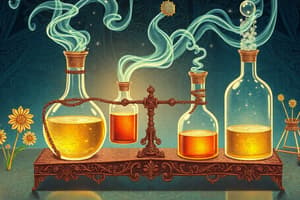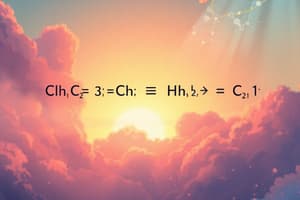Podcast
Questions and Answers
What are the different types of chemical reactions?
What are the different types of chemical reactions?
The different types of chemical reactions are synthesis, decomposition, single replacement, double replacement, combustion and redox reactions.
How do you balance a chemical equation?
How do you balance a chemical equation?
To balance a chemical equation, you need to adjust the coefficients of the reactants and products so that the number of atoms of each element is the same on both sides of the equation.
What is the law of conservation of mass?
What is the law of conservation of mass?
The law of conservation of mass states that in a chemical reaction, the total mass of the reactants is equal to the total mass of the products.
What are the five general types of chemical reactions?
What are the five general types of chemical reactions?
What is the difference between a chemical reaction and a chemical equation?
What is the difference between a chemical reaction and a chemical equation?
How is the stoichiometry of a chemical reaction related to the coefficients in the balanced chemical equation?
How is the stoichiometry of a chemical reaction related to the coefficients in the balanced chemical equation?
Flashcards
Types of Chemical Reactions?
Types of Chemical Reactions?
Reactions include synthesis, decomposition, single/double replacement, combustion, and redox.
Balancing Chemical Equations?
Balancing Chemical Equations?
Adjust coefficients to ensure the same number of atoms for each element on both sides.
Law of Conservation of Mass?
Law of Conservation of Mass?
Mass is neither created nor destroyed; the total mass of reactants equals the total mass of products.
Five General Reaction Types?
Five General Reaction Types?
Signup and view all the flashcards
Reaction vs. Equation?
Reaction vs. Equation?
Signup and view all the flashcards
Stoichiometry and Coefficients?
Stoichiometry and Coefficients?
Signup and view all the flashcards
Study Notes
Chemical Reactions and Equations
- There are five general types of chemical reactions: synthesis, decomposition, single displacement, double displacement, and combustion reactions.
Balancing Chemical Equations
- To balance a chemical equation, the number of atoms of each element must be equal on both the reactant and product sides.
- This is achieved by adding coefficients (numbers in front of formulas of reactants or products) to the equation.
Law of Conservation of Mass
- The law of conservation of mass states that matter cannot be created or destroyed in a chemical reaction, only transformed from one substance to another.
- This means that the total mass of reactants is equal to the total mass of products in a chemical reaction.
Chemical Reactions and Equations
- A chemical reaction is a process in which one or more substances are converted into new substances.
- A chemical equation is a representation of a chemical reaction using chemical formulas and symbols.
- The equation shows the reactants (starting materials) on the left and the products (resulting substances) on the right.
Stoichiometry and Balanced Equations
- The stoichiometry of a chemical reaction is the quantitative relationship between reactants and products.
- The coefficients in a balanced chemical equation represent the mole ratios of reactants and products.
- These coefficients are used to calculate the amounts of reactants required or products formed in a reaction.
Studying That Suits You
Use AI to generate personalized quizzes and flashcards to suit your learning preferences.




